一、程序和⽤户交互
python 中 使⽤ input 函数实现
input("这⾥写提示信息, 必须使⽤引号引起来")
二、变量
In [1]: n = input("输入数字")
输入数字8
In [2]: n
Out[2]: '8'

1.变量命名潜规则:
- 不要以单下划线和双下划线开头;如:_user或 __user
- 变量命名要易读;如:user_name,⽽不是username
- 不⽤使⽤标准库中(内置)的模块名或者第三⽅的模块名
- 不要⽤这些 Python 内置的关键字:
In [4]: keyword.kwlist
Out[4]:
['False', 'None', 'True', 'and', 'as', 'assert',
'break', 'class', 'continue', 'def', 'del', 'elif',
'else', 'except', 'finally', 'for', 'from', 'global',
'if', 'import', 'in', 'is', 'lambda', 'nonlocal',
'not', 'or', 'pass', 'raise', 'return', 'try',
'while', 'with', 'yield']
2.如何理解 python 的变量赋值
s = 'hello'- hello 这个对象会在内存中先被创建,之后再把变量名 s 分配给这个对象。
- 所以要理解 Python 中的变量赋值,应该始终先看 等号右边 。
- 对象是在右边先被创建或者被获取 ,在此之后左边的变量名才会被绑定到对象上,这就像是为对象贴上了⼀个标签。
- ⼀个对象可以有多个标签或者名字 。 ⽐如: 我们⾃⼰就有很多名字,身份证上的名字,⽹络昵称等。
示例:
In [5]: a = 1
In [6]: b = a
In [7]: a = 2
In [8]: b
Out[8]: 1
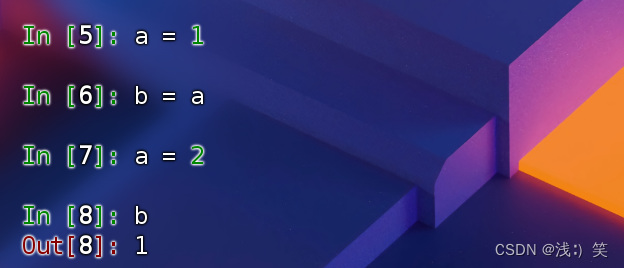
3.多元赋值
字符串以及后⾯讲的列表、元组都⽀持这种操作,也要元组解包
In [1]: n1, n2 = 1, 2
In [2]: n1
Out[2]: 1
In [3]: n2
Out[3]: 2
In [4]: s1, s2 = '12'
In [5]: s1
Out[5]: '1'
In [6]: s2
Out[6]: '2'
In [7]: num, s = [10, 'hello']
In [8]: num
Out[8]: 10
In [9]: s
Out[9]: 'hello'
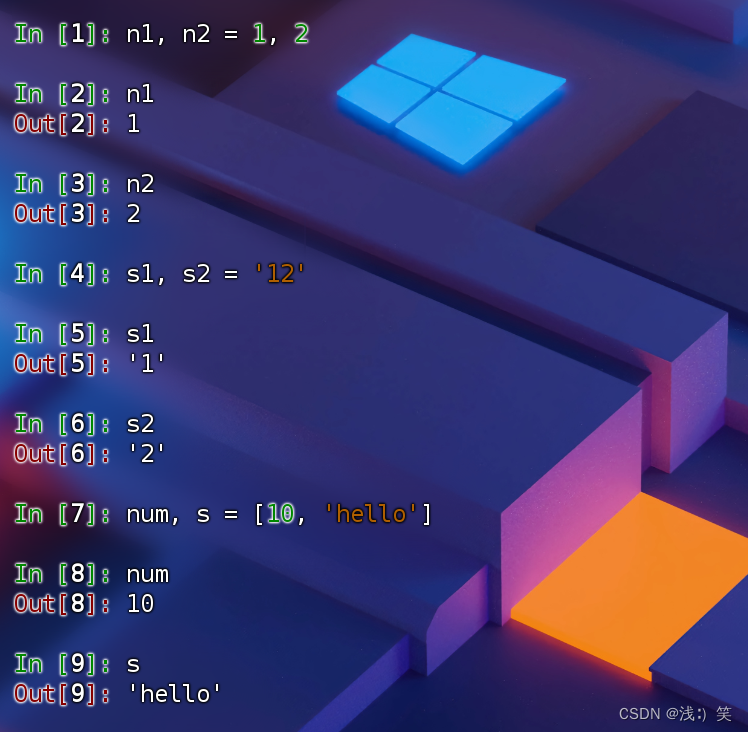
三、判断条件
In [10]: n = 10
In [11]: n == 10
Out[11]: True
In [12]: n != 10
Out[12]: False
In [13]: n > 10
Out[13]: False
In [14]: n < 10
Out[14]: False
In [15]: n <= 10
Out[15]: True
In [16]: n >= 10
Out[16]: True
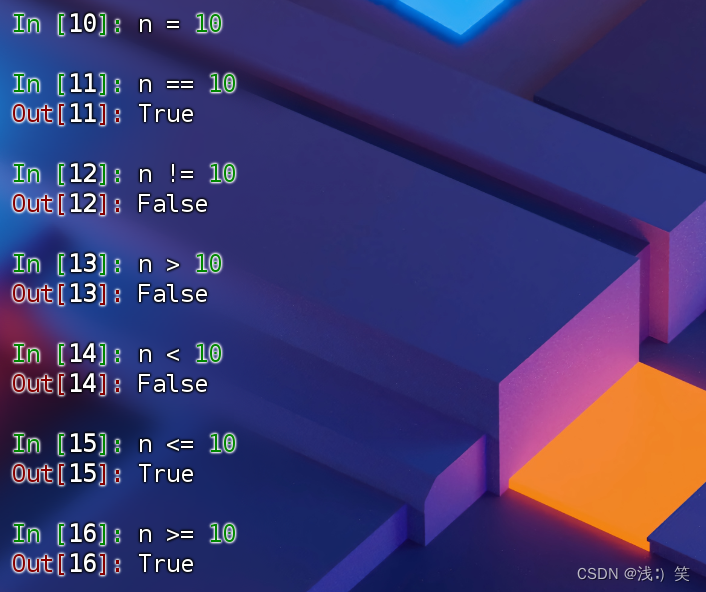
示例
In [17]: n = input("请输入一个数字:")
请输入一个数字:10
In [18]: n == 10
Out[18]: False

会发现返回 False 在编程语⾔中 ,数据是有类型之分的。input() 接收到的任何数据都会成为 字符串类型(str),就是普通的字符串 ⽽ 我们等号 右边的 10 是整型(int)
四、 数据类型
1.查看数据的类型,使⽤ type
In [19]: n
Out[19]: '10'
In [20]: type(n)
Out[20]: str
In [21]: type(10)
Out[21]: int
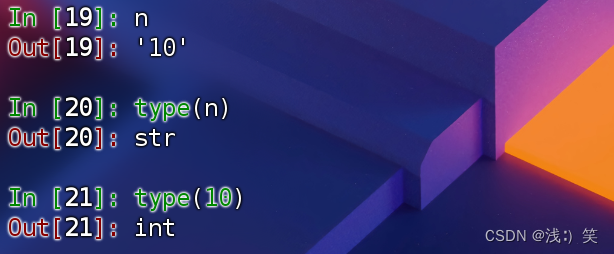
2.基本的数据类型
整型(int)
In [21]: type(10)
Out[21]: int
In [22]: type(0)
Out[22]: int
In [23]: type(-1)
Out[23]: int
In [24]: type(1)
Out[24]: int
浮点型(带⼩数点的⼩数)
In [25]: type(1.1)
Out[25]: float
In [26]: type(-1.1)
Out[26]: float
布尔型
In [27]: type(True)
Out[27]: bool
In [28]: type(False)
Out[28]: bool
字符串(str)
In [29]: type('10')
Out[29]: str
In [30]: type('hello')
Out[30]: str
In [31]: type('-1.1')
Out[31]: str
⼆进制(bytes)
In [32]: type(b'hello')
Out[32]: bytes
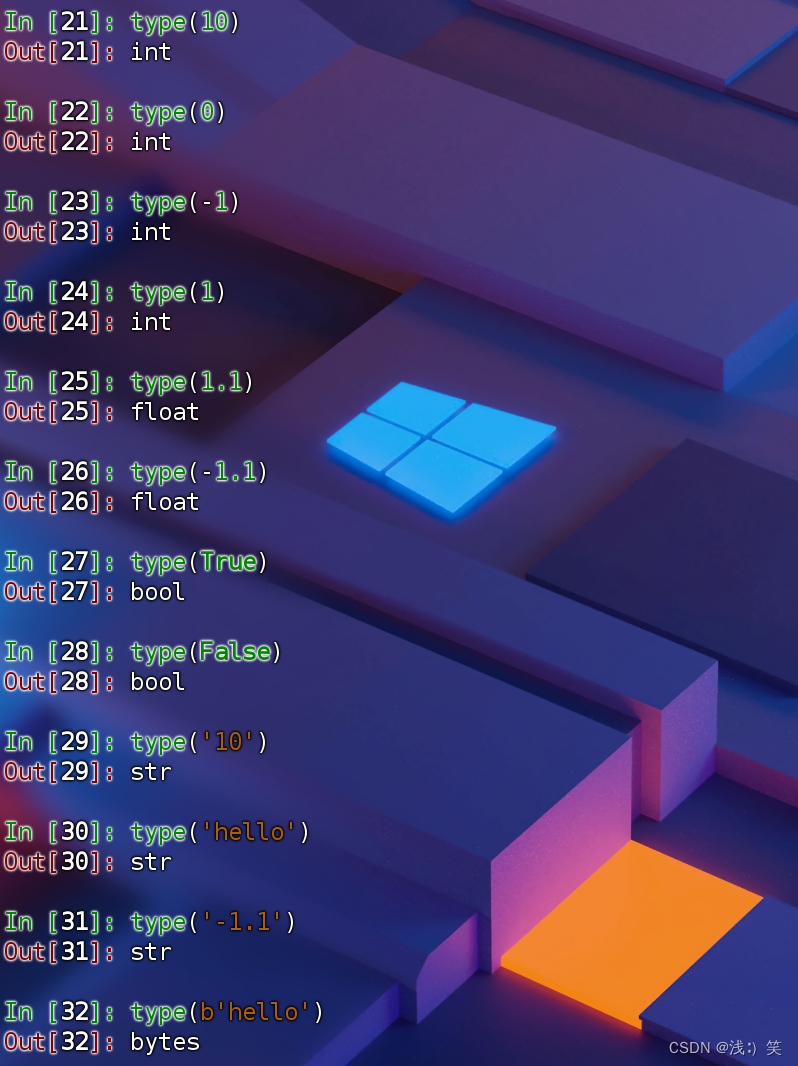
五、类型转换
转换为 int
In [33]: int('10')
Out[33]: 10
In [34]: int('-10')
Out[34]: -10
In [36]: int(1.9)
Out[36]: 1
转换为 float
In [37]: float(1)
Out[37]: 1.0
In [38]: float(-1)
Out[38]: -1.0
In [39]: float('1.1')
Out[39]: 1.1
转换为 str
In [40]: str(111)
Out[40]: '111'
In [41]: str(111.1)
Out[41]: '111.1'
In [42]: str(b'hello', encoding='utf-8')
Out[42]: 'hello'
转换为⼆进制
In [43]: bytes('亮', encoding='utf-8')
Out[43]: b'\xe4\xba\xae'
In [44]: b = bytes('亮', encoding='utf-8')
In [45]: b
Out[45]: b'\xe4\xba\xae'
In [47]: str(b, encoding='utf-8')
Out[47]: '亮'
In [48]: type(b)
Out[48]: bytes
In [49]: s = str(b, encoding='utf-8')
In [50]: s
Out[50]: '亮'
In [51]: type(s)
Out[51]: str
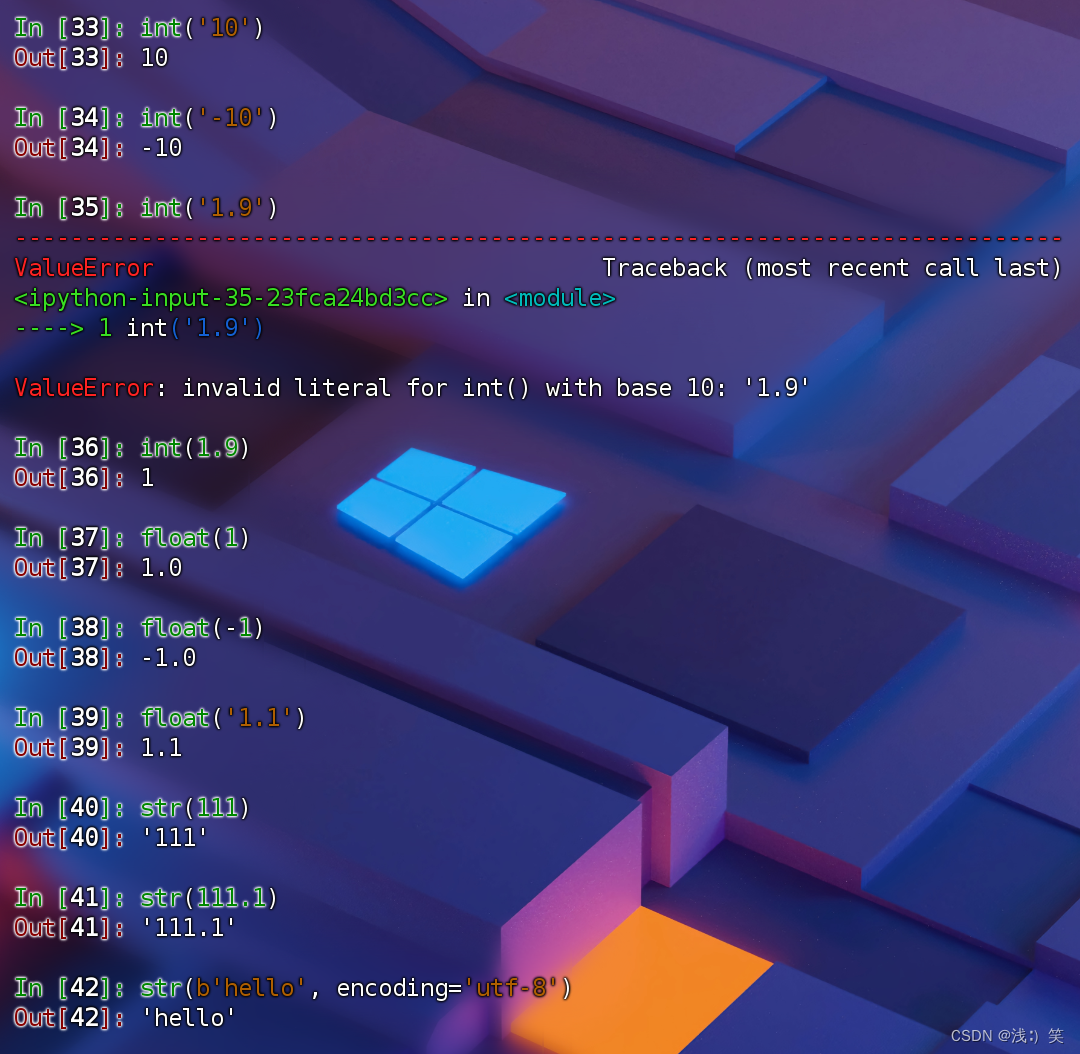
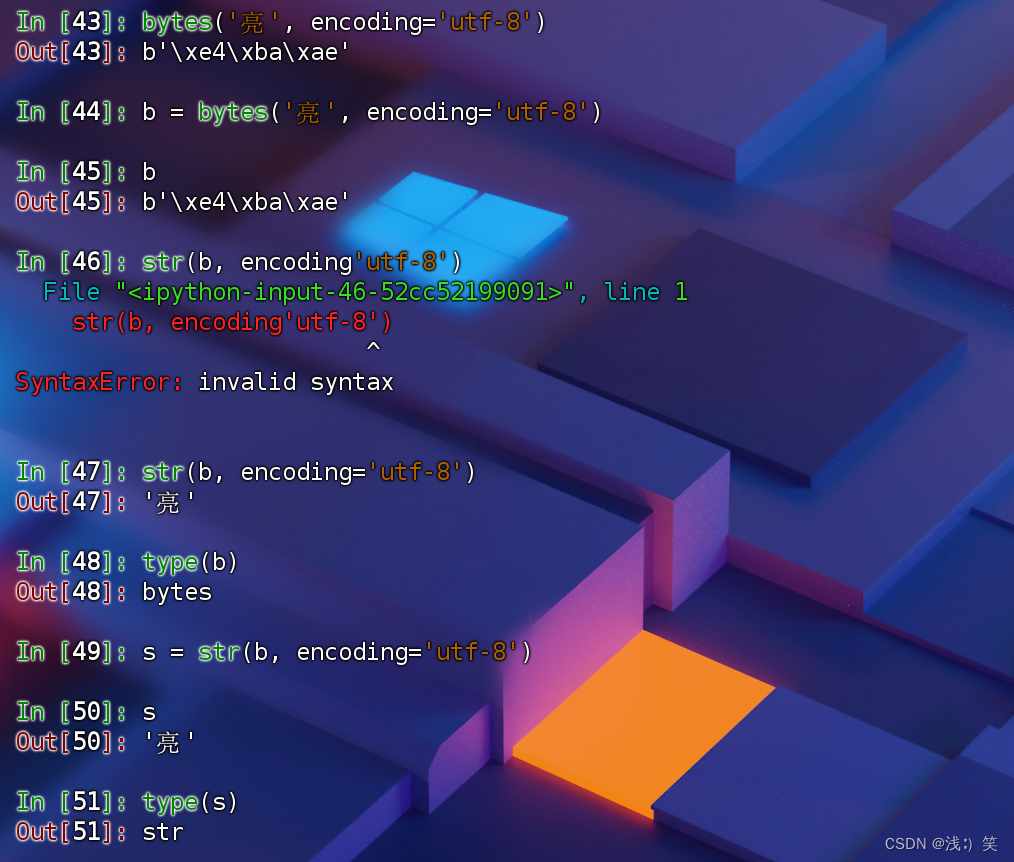
六、if 判断语句
语法⼀:
if 判断条件: # 冒号必须的
如果判断条件为真,执⾏这⾥的代码,这⾥的代码必须缩进4个空
格
并且每⼀⾏代码的缩进要⼀致示例
In [52]: n = input("请输入一个数字:")
请输入一个数字:18
In [53]: int(n)
Out[53]: 18
In [54]: type(n)
Out[54]: str
In [55]: n = int(n)
In [56]: type(n)
Out[56]: int
In [57]: if n == 18:
...: print("相等")
...:
相等
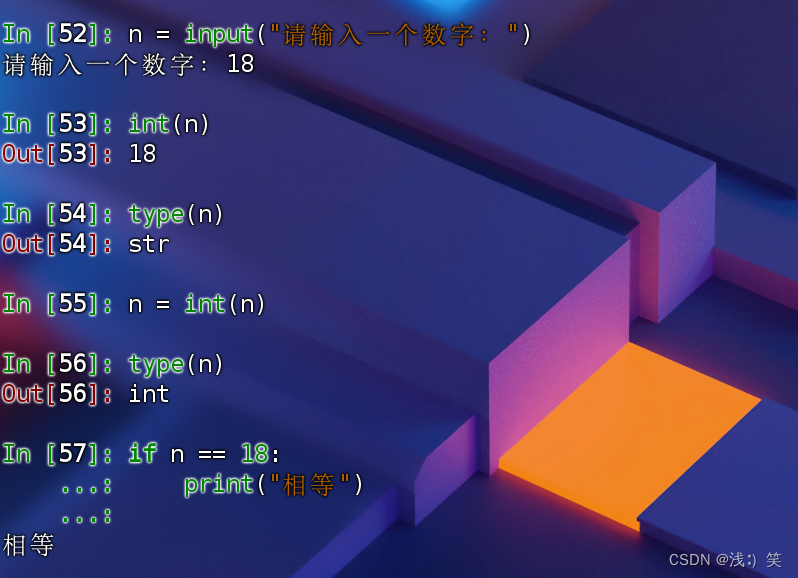
语法⼆:
if 判断条件:
如果判断条件为真,执⾏这⾥的代码
else: # 这⾥的冒号也是必须的
如果判断条件为假,执⾏这⾥的代码,这⾥的代码必须缩进4个空
格
并且每⼀⾏代码的缩进都要⼀致In [58]: n = 19
In [59]: if n == 18:
...: print("相等")
...: else:
...: print("不相等")
...:
不相等
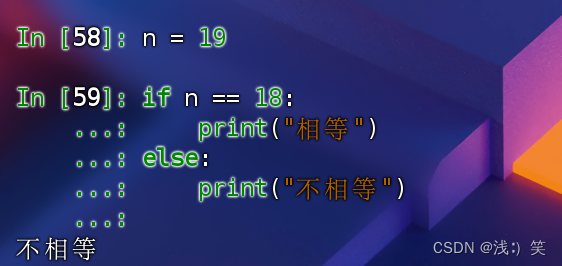
语法三:
if 判断条件:
如果判断条件添加为真,执⾏这⾥的代码,这⾥的代码必须缩进4
个空格
并且每⼀⾏代码的缩进要⼀致
elif 判断条件: # 这⾥同样需要加条件
如果判断条件添加为真,执⾏这⾥的代码,这⾥的代码必须缩进4
个空格
并且每⼀⾏代码的缩进要⼀致
else: # 这⾥的冒号也是必须的
如果判断条件为假,执⾏这⾥的代码,这⾥的代码必须缩进4个空
格
并且每⼀⾏代码的缩进都要⼀致 elif 根据需求可以出现多个
示例
In [61]: n = 17
In [62]: if n == 18:
...: print("相等")
...: elif n > 18:
...: print("大了")
...: elif n < 18:
...: print("小了")
...:
小了
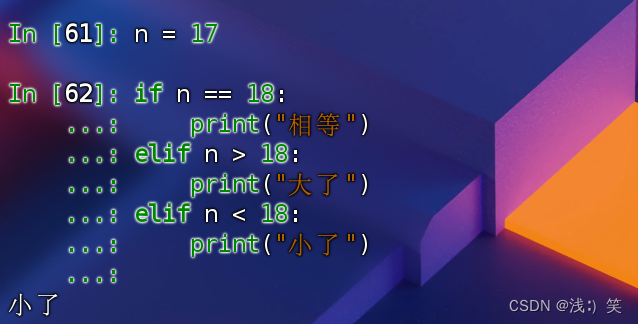
七、Python 程序
通常我们会把程序的代码写的⼀个⽂件种,这个⽂件就成为 Python 的⼀个程序⽂件,⽂件名⼀般都是以 .py 为结尾,有时候也成为 ⼀个 python 的程序。
需求:使⽤ vi 编辑器,写猜数游戏的⼩程序
示例:
[root@192 ~]# vi hello.py
#!/usr/bin/env python3
# file name hello.py
print("猜数游戏开始")
n = input("请输⼊⼀个数字")
n = int(n)
if n == 18:
print("猜对了")
elif n > 18:
print("⼤了")
else:
print("⼩了") 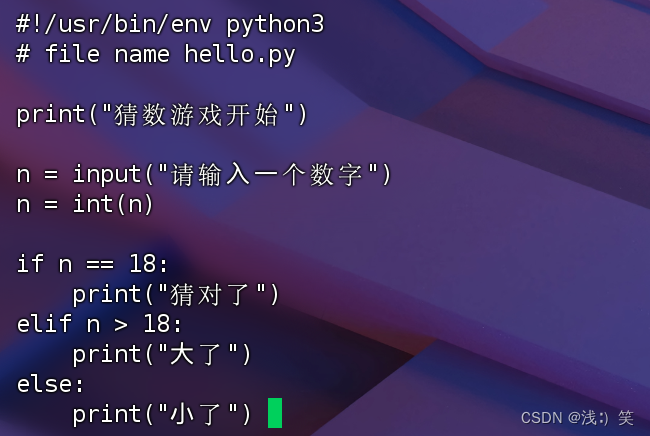
第⼀⾏不是注释,和 shell 脚本⼀样,是在声明这个脚本默认使⽤的解释器
执⾏ python 程序
[root@192 ~]# python3 hello.py
猜数游戏开始
请输⼊⼀个数字19
⼤了
[root@192 ~]# python3 hello.py
猜数游戏开始
请输⼊⼀个数字8
⼩了
[root@192 ~]# chmod +x hello.py #给权限
[root@192 ~]# ./hello.py
猜数游戏开始
请输⼊⼀个数字8
⼩了
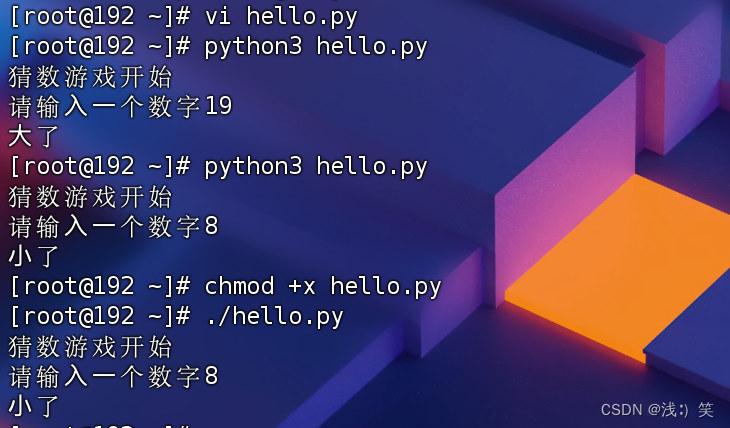






















 65
65











 被折叠的 条评论
为什么被折叠?
被折叠的 条评论
为什么被折叠?








